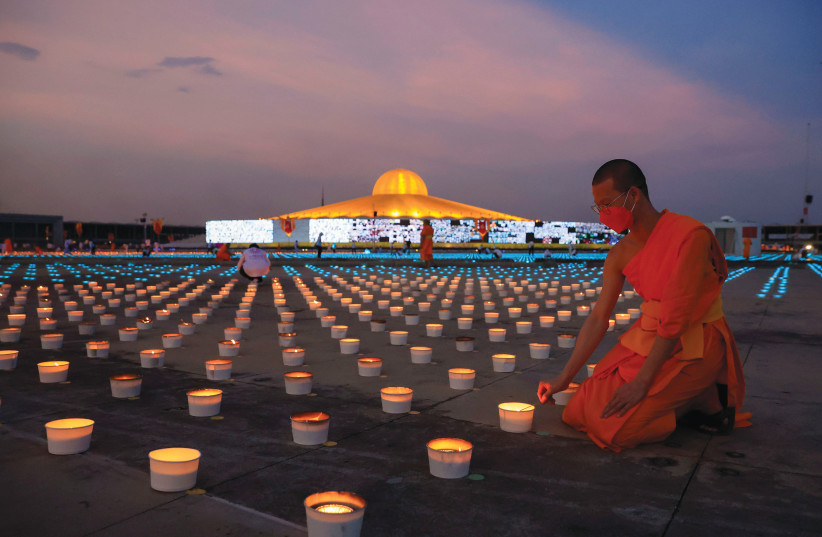Passover in the shadow of the climate crisis

The climate crisis, which is already raining down plagues upon the earth, advances at an accelerated pace. The doom of millions of people and thousands of species, barring a miracle, is inevitable.
I imagine the terrible fear of the Israelites as Pharoah’s army galloped toward them and they were trapped on the other side by the waters of the Red Sea. Their doom, barring a miracle, was inevitable.
The climate crisis, which is already raining down plagues upon the earth, advances at an accelerated pace. On the horizon is the inevitable death by water or fire or pestilence, depending on which part of the vulnerable and convulsing planet one inhabits and in which season. The doom of millions of people and thousands of species, barring a miracle, is inevitable.
This year, Passover, Easter and Ramadan take place in proximity to Earth Day, April 22nd, which is a global day of action in which faith communities especially are being asked by a coalition organized by the New York-based Peace Department to undertake climate projects.
The Secretary General of the United Nations, Antonio Guterres, said at the conclusion of the United Nations Climate Conference in Egypt, that “COP27 took place not far from Mount Sinai, a site that is central to many faiths and to the story of Moses or Musa. It’s fitting. Climate chaos is a crisis of biblical proportions. The signs are everywhere. Instead of a burning bush, we face a burning planet.”
And yet world leaders will gather once again later this year for the next UN Climate Conference, COP 28, to be held in Dubai and chaired by Sultan al-Jaber, the CEO of the Abu Dhabi National Oil Company.
To what is our generation enslaved? Oil and gas, yes; short-term greed, yes. So what is the path to liberation if the very climate conference meant to save humanity and the planet is hosted by one of the pharaohs of oil and gas?
Dayenu: A Jewish climate activist group launched on Passover
Two years ago on Passover, Rabbi Jennie Rosenn, one of my activist heroes, launched a new Jewish climate activist group called, appropriately, Dayenu.
DURING THE weeks around the Passover holiday, Jews and allies organized by Dayenu circles gather outside the branches and offices of banks and asset managers that continue to invest money in Fossil Fuel Pharaohs: the oil, gas and coal companies. They recited the modern-day fossil-fueled plagues that the oil, gas and coal industries are casting upon us.
According to Dayenu: “We will bring matzah with us as we deliver a letter to the financial institutions to symbolize our call to action that we call upon Chase, Bank of America, Wells Fargo, Citigroup, Vanguard and BlackRock to act with haste, stop investing in dirty fossil fuels and join us in leaving the polluting past behind and moving towards a just and livable future. We’ll demand they move their dough.
The Israelites freed from Egypt never made it to Israel because they remained enslaved to a defeatist mentality that their physical freedom couldn’t shake off. The generation of the desert died in the desert, leaving their children to cross the Jordan. The sin of worshiping the golden calf broke God’s confidence in that generation of God’s chosen people.
One of the great challenges of the climate crisis is that we don’t have the luxury of waiting for another generation, despite the fact that our generation has fueled the fossil fuel industry’s enslavement of civilization, including that of Israel.
We have the physical ability to be free; for example, solar-plus-storage is cheaper in Israel than the gas monopoly, yet 90% of Israel’s power is climate dirty. Israel has a dynamic climate-tech ecosystem that can solve the climate crisis worldwide but, apparently, not at home. Why? Because mentally, we are dor hamidbar, the generation that has sinned and can’t seem to mentally free ourselves of our power pharaohs.
This means that we are proud of civil society for recently standing up to the slide to tyranny but the very same civil society is essentially silent about Israel having one of the worst climate policies and practices in the Western world. We are part of the problem, not the solution. And Israel’s monopolistic climate policies have been imposed on its citizens by the very same masters who have recently tried to monopolize every branch of government.
With climate disaster galloping toward us, how do we split the sea in time?
We have to take the plunge, like Nachshon, who the rabbis describe as the first to jump into the Red Sea to challenge God to a timely miracle.
FROM A policy perspective, Israel can easily reach 50% renewables by 2030 – maybe even 100% – which is what every country has to do or else the sea won’t split but rise.
Eighty percent of Israelis celebrated their seders in apartment buildings. The finance ministry has ensured that those in shared buildings won’t add solar to their rooftops by capping unfairly and unnecessarily the VAT tax exemption in solar for them. Lifting that cap will lift the share of renewables powering our country to 30%, a climate-busting miracle that awaits a leader to make it happen. We are the world leader in solar water heaters on our rooftops; we could be so for electricity as well.
Those of us in Israel who are celebrating Ramadan are deeply discriminated against when it comes to climate justice in Israel. Yet the only way Israel can scale solar fields to meet UN climate goals is to resolve the land issues once and for all in an equitable way for the Bedouin. Over the past decade, no Bedouin has compromised with the state on their land because the state has been insulting, derogatory and untrustworthy.
The Bedouin land issues can be resolved with a government-approved equitable compromise that guarantees that families who sign on will receive a utility-scale solar field on their land, guaranteed grid interconnection, rental income and jobs. Ten thousand Bedouin jobs can be created in the Negev along with 5,000 MW of solar power but this climate-busting miracle is waiting for a leader to make it happen. Bedouin solar fields, along with shared rooftops, can bring Israel to 50% renewables by 2030, matching the targets and program of the European Union and the United States.
Passover is a spring holiday, with the harvest upon us. Israel could actually make the leap to 100% renewables by allowing the 900 kibbutzim, moshavim and recognized Arab villages to each produce 50 MW of agrovolatics – solar panels above productive agriculture. Calibrated correctly, agricultural crop yields can actually improve, given that global warming is beginning to chip away at our agricultural production and the extra shade can be helpful. Throw in energy storage and the grid can take it. Remarkably, power prices will be lower because solar-plus-storage is half the price that the pharaohs of our energy are making us pay today. Nine hundred fields of 50 MW each is more than enough to power the entire country and Jordan day and night.
The government of Israel’s heart is hardened when it comes to freeing our people of the expensive and polluting gas monopoly. It will, unfortunately, take the plague of darkness – after Hezbollah strikes the gas rigs near our coast or Iranian hackers down the grid – before Israel can assume her role as a renewable light unto the nations. The coalition agreement for this government actually calls for a climate bill with a 50% renewables goal by 2030; therefore, the miracle is in reach.
Yosef Israel Abramowitz, one of Israel’s leading climate activists and investors, serves as the CEO of impact platform Energiya Global Capital and co-chairs Shamsuna: The Sayyid Al-Harumi initiative for Bedouin solar. In 2023, he was nominated by MK Alon Tal for the Nobel Peace Prize for pioneering solar in Israel, Africa and Gaza and can be followed via @KaptainSunshine.■
Jerusalem Post Store
`; document.getElementById("linkPremium").innerHTML = cont; var divWithLink = document.getElementById("premium-link"); if (divWithLink !== null && divWithLink !== 'undefined') { divWithLink.style.border = "solid 1px #cb0f3e"; divWithLink.style.textAlign = "center"; divWithLink.style.marginBottom = "15px"; divWithLink.style.marginTop = "15px"; divWithLink.style.width = "100%"; divWithLink.style.backgroundColor = "#122952"; divWithLink.style.color = "#ffffff"; divWithLink.style.lineHeight = "1.5"; } } (function (v, i) { });

